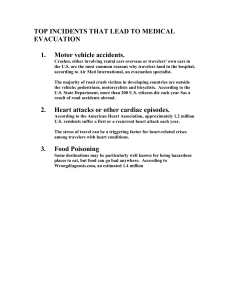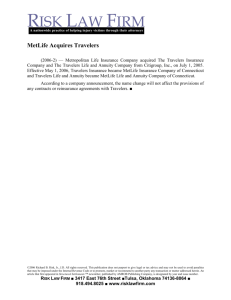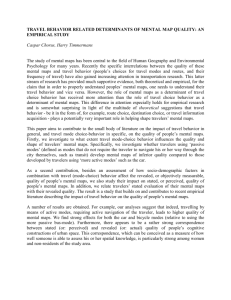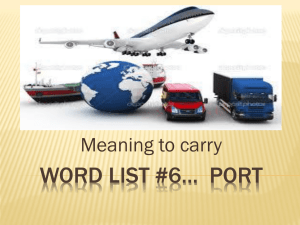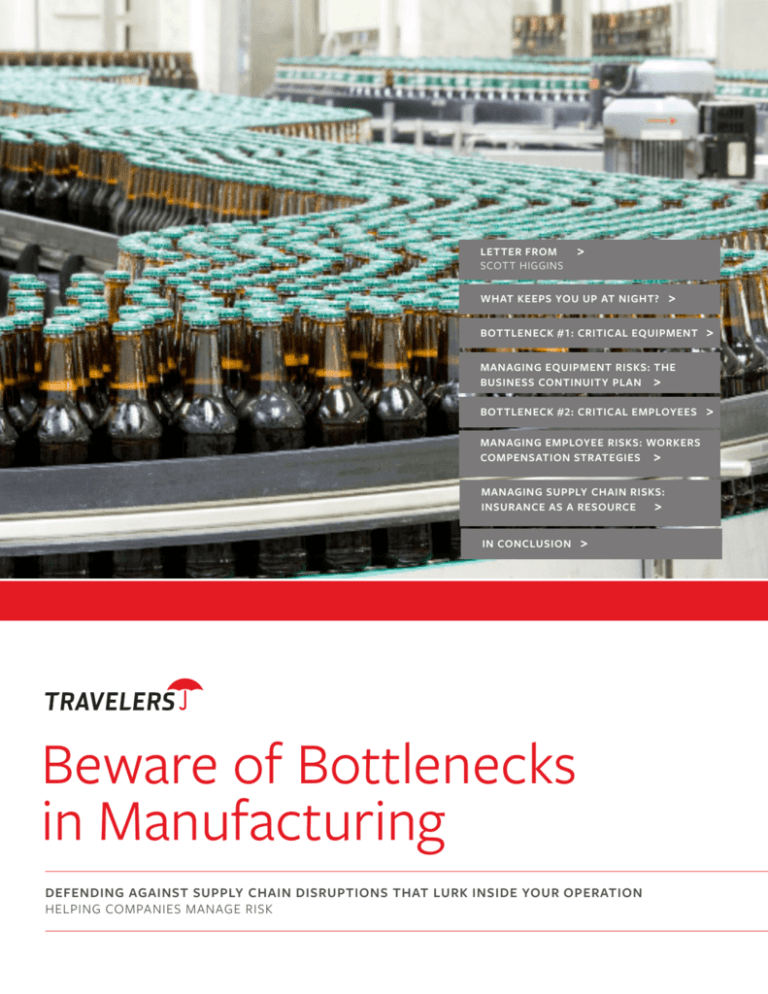
LETTER FROM
>
SCOTT HIGGINS
WHAT KEEPS YOU UP AT NIGHT?
>
BOTTLENECK #1: CRITICAL EQUIPMENT
>
MANAGING EQUIPMENT RISKS: THE
BUSINESS CONTINUITY PLAN >
BOTTLENECK #2: CRITICAL EMPLOYEES
MANAGING EMPLOYEE RISKS: WORKERS
COMPENSATION STRATEGIES >
MANAGING SUPPLY CHAIN RISKS:
INSURANCE AS A RESOURCE >
IN CONCLUSION
>
Beware of Bottlenecks
in Manufacturing
DEFENDING AGAINST SUPPLY CHAIN DISRUPTIONS THAT LURK INSIDE YOUR OPERATION
HELPING COMPANIES MANAGE RISK
>
The weakest link in your supply chain
just may be in your plant
Thirty years ago, when a financial
consultant first coined the term
“supply chain management,” the
focus was on getting materials in
the door to use in manufacturing
finished products. Today, the
definition of supply chain has
broadened to include the entire
lifecycle of a product.
From sourcing raw materials to
manufacturing finished goods to
delivering products to customers to satisfying warranty
commitments, successful manufacturers look at their supply
chain holistically. At every step of this new supply chain
paradigm, there are opportunities to improve, efficiencies to
capture – and risks to manage.
In this article, Travelers brings you information to help you
manage internal supply chain risks. Topics include:
•
Internal bottlenecks that can disrupt operations
•
Risks and strategies for protecting critical equipment
•
Risks and strategies for managing critical employees
•
Insurance resources for effective supply chain risk management
At Travelers, we offer both online resources and risk
management specialists who are ready to help protect your
productive capacity.
Scott Higgins
President, Travelers Commercial Accounts
When the supply chain is external, many of the risks are obvious.
Companies look at the potential for disruption and often plan for
alternatives that can be put in place quickly, but the parts of the
supply chain that run through a company’s own operations are
sometimes overlooked. And that can leave a company vulnerable
when a weak link in the chain comes apart unexpectedly.
travelers.com
PAG E
1
What keeps you up at night?
contamination
of raw materials
can be an issue,
through either the
deliberate substitution of cheaper ingredients or the lack of
proper handling and quality control by suppliers. Getting the
wrong materials, especially if the problem is not caught before
the manufacturing process, can severely impact the quality of a
company’s finished goods.
•
When it comes to a company’s supply chain, there are multiple
aspects that can break down and disrupt operations. Consider
these examples, all of which are rooted in real-world
experiences.
•
•
Will it get to you when you need it? Keeping a manufacturing
plant operating at full capacity requires a flow of materials
that is dependable. A plant can be idled unexpectedly when a
tsunami in Japan puts suppliers out of business, or volcanic
ash high above Europe grounds the air transport scheduled to
deliver materials to a manufacturer.
Will it be what you ordered? Manufacturers issue
specifications for both the quality and functionality of materials
they expect to get from suppliers. But counterfeit components
are a growing concern, as demonstrated by the seizure of
64,000 fake automobile parts in Dubai last year. The parts,
which carried the brand names of major automotive companies
but were only shoddy counterfeits, were declared a major
threat to safety and destroyed. In addition to counterfeits,
Will it affect your reputation? The source of supplies can
come back to haunt a company, as the Bangladesh factory
collapse did for clothing retailers, or as mistreatment of
Chinese factory workers did for a technology company. In
today’s hyper-connected world, the integrity of a supplier has
implications for the manufacturer because customers often
react to scandals by shunning the associated products.
These supply chain risks are well-recognized. But many others
lurk within a manufacturing operation. The failure of both
equipment and human assets can put an operation at risk.
Not just any piece of equipment or human asset, however – in
some cases, a broken machine can be repaired or a different
worker can be hired. Instead, the risk comes from that single
point of failure where, when something goes wrong, it is very
difficult for a company to recover.
For example, a critical piece of equipment that cannot be easily
replaced or repaired can bring production to a halt. Similarly, a
specially trained worker who is injured may leave a company
without the skills it needs to continue operations. These are
examples of the bottlenecks that must be identified and
addressed for effective risk management.
Potential Impact of Manufacturing Bottlenecks
Event
Fire, flood or other major event destroys
critical equipment
Risk
Up to 40% of businesses fail after a
disaster*
Outcome
Business Interruption
*Insurance Information Institute
travelers.com
PAG E
2
Bottleneck #1: Critical Equipment
For many types of industries, when a piece of equipment breaks down or is
destroyed during a catastrophic event (for example, a fire or earthquake),
a replacement can be brought into play quickly, even if at great expense,
so productivity continues. Construction companies can replace bulldozers,
trucks and jackhammers; a financial consulting firm can locate and install
new computer equipment; a food services company can obtain new ovens
and refrigerators.
In manufacturing, however, machinery is often highly specialized.
Purchased years before a breakdown, it may have been heavily
modified over time with upgrades and adaptations. When a
customized piece of equipment like this malfunctions and cannot
be repaired, it may be impossible to replace at any price, or a
replacement may take too long. For example, a machine that
is made by only a single small company in Germany may have a
three-year waiting period from placement of order to delivery
of the equipment.
If a piece of equipment is critical to a manufacturer’s operations,
it has the potential to be a single point of failure – a bottleneck
that can shut down production. And that makes it important to
consider high-value machinery as part of the supply chain that
should be managed to reduce risk.
EVERYWHERE IS VULNERABLE TO DISASTER
Even for lesser equipment that under normal circumstances can
be quickly replaced, market conditions may change. A natural
disaster can turn normally sleepy markets with ample supplies of
second-hand equipment into hotbeds of shortages, escalating
bids and disappointed would-be buyers. And as the map at right
indicates, there are no areas of the United States that are risk-free
when it comes to natural catastrophes.
Critical equipment can be sidelined by more than just breakdowns
or disasters. For example, power outages can also take a machine
offline and disrupt productivity. If an outage is unexpected or if
there is a reduction in voltage (a brownout), equipment could
be damaged.
travelers.com
PAG E
3
Managing Equipment Risks:
The Business Continuity Plan
Your company may already have a business continuity plan on the shelf –
the prescription for what to do when disaster strikes and production comes
to a halt. However, many plans fail to address all potential bottlenecks, such
as the steps to take when a critical piece of equipment breaks down. The
most effective plans help companies prepare for the unexpected, protect
assets, respond to emergencies, and recover fully operational capabilities in
a timely manner.
The following is a checklist that Travelers uses when our risk control consultants work with
customers to help them create effective contingency plans for equipment:
•
•
•
•
•
•
List of key equipment. The first step is to identify key equipment, taking note of any
factors that could make it difficult to replace or repair. Key equipment either has a high
dollar value and/or is critical to the operation of the business.
Inventory of spare parts. The plan should identify all spare parts that are kept on site, as
well as provide a list of sources for purchasing necessary equipment that could be used
to repair or replace a non-functioning machine. Each year, the list should be updated with
pricing and delivery times for obtaining necessary parts.
Getting Proactive
with Your Supply
Chain
Rental equipment. A list of sources for rental equipment should be developed, with
details about cost for rental, set-up, breakdown, shipping both ways and estimated time
from placement of order to start-up. If permits are required to move heavy equipment
or install a new machine, the necessary steps should be identified.
In its 2013 annual report, the Supply
Chain Risk Leadership Council
advised companies to become
proactive about managing risk:
Contractors. Several contractors who are qualified to work on or repair equipment
should be identified, including information about their capabilities and availability.
“We believe it is critical that
enterprises, in addressing emerging
supply chain risks, move from being
reactionary to being proactive
and resilient, KNOWING that
at some point, somehow, and
perhaps frequently, your business
will be impacted by a supply chain
disruption of one form or another.
Business loss alternatives. To avoid losing sales or falling behind on contractual
obligations, a manufacturer may want to consider several alternatives if an equipment
failure disrupts production. These include making arrangements with competitors to
outsource work during an emergency; keeping inventory on hand to provide product to
customers when the manufacturing line is down; and running other equipment longer
hours (requiring overtime shifts) to make up for lost production.
Alternative sites. Among considerations in the business continuity plan can be
identifying or developing alternative sites: A “cold” site is a place where machinery and
people could be placed to restart production in the event of an emergency. A “warm” site
typically makes use of someone else’s resources in off hours to allow return to production
much more quickly. A “hot” site, often implemented in the technology world, mirrors
existing facilities and is run in tandem with current operations.
travelers.com
Therefore, it is no longer sufficient
to tackle many issues once they
have started to directly affect your
enterprise. They should be factored
into your overall supply chain
planning and operational processes
in advance, with plans in place to
respond quickly and effectively
when these risks become reality.”
PAG E
4
Bottleneck #2:
Critical Employees
When a machine is taken out of production by something like a factory fire, the impact
on operations is direct and obvious to the manufacturer. With human assets, the
impact from a change in status of a single worker may be more subtle – perhaps even
unnoticeable until something happens and operations are disrupted.
At one manufacturing plant, this lesson was learned the hard way. A single worker who
was a tool-and-die expert was responsible for maintaining machinery throughout the
plant, making repairs on the spot. When cost-cutting measures went into effect, he
was laid off as a non-essential employee. However, efficiency quickly went downhill as
equipment broke down and other repair arrangements that were more time-consuming
and less satisfactory had to be made. Once the manufacturer realized how valuable the
employee was, he was rehired.
Many companies have key employees with specialized skills who cannot easily be
replaced. Perhaps these employees are familiar with legacy systems within a plant that
less experienced workers do not know how to operate. They may know how to program
digital equipment using obsolete computer coding. Or they may have skills that are no
longer routinely taught in school, such as welding.
These high-value employees can become incapacitated or unavailable to a manufacturer
in a number of ways. They may age in place and retire; they may be injured on the job
and not have their workers compensation claim managed in a way that gets them back
on the job quickly; they may obtain other employment during a plant closure and not
return; or they may simply find another job that they prefer.
In addition to high-value employees, a manufacturer’s general workforce is also critical to
smooth operations. Because of the nature of manufacturing, where employees are often
dealing with heavy equipment and stressful or repetitive motions, workers compensation
injuries can be a major threat to plant productivity. In 2011 (the last year for which
statistics are available), the U.S. Bureau of Labor Statistics stated that more than 11.6
million people worked in the manufacturing industry – and more than 500,000 suffered
an injury severe enough to remove them from their jobs at least temporarily.
With both equipment and human assets identified as critical links in the internal supply
chain, it becomes imperative for manufacturers to plan strategies for addressing
disruptions, just as they would for their external supply chain.
Plant Consolidation Spikes Workers
Compensation Cases
Sometimes when high-value equipment
and high-value employees come
together, the result is workplace
disruption and high costs. Effective risk
management, however, can turn the
situation around.
When a Connecticut manufacturer
consolidated machinery and workers
from two plants being closed into
the company’s one remaining facility,
workers compensation claims jumped
48 percent and the cost per claim rose
84 percent. The largest category of
injuries was musculoskeletal disorders.
Working in tandem with risk
management specialists from Travelers,
the manufacturer’s human resources
and safety staff soon realized that
the transferred equipment was not
ergonomically designed which was
addressed with retrofitting. But a bigger
problem was the lack of adequate
training and communication so that
workers understood the need to get
help early, before injuries became
intractable.
By aggressively tackling both
ergonomic issues and post-injury
management practices, Travelers and
the manufacturer were able to reverse
the situation, improve the workplace
environment, and return to full
productivity.
The Hidden Costs of Workers Compensation Injuries
Meeting the needs of an injured worker can be costly, between medical treatment and time off work. However, the American
Society of Safety Engineers has concluded that the indirect costs and impacts of a worker injury are four to 10 times greater than
the direct costs. They include:
•
Hiring temporary workers with adequate skills to replace the injured employee.
•
Loss of operational time, which results in fewer products completed to sell to customers.
•
Impact on morale of other employees, who may question the workplace safety environment.
•
Administrative costs for handling the injury claim.
travelers.com
PAG E
5
Managing Employee Risks:
Workers Compensation Strategies
Protecting productivity when it comes to human assets requires multiple layers of initiatives.
Succession planning to replace aging critical employees is important, as are recruiting employees
with the right skill sets and cross-training employees. But perhaps the most critical strategy is to
manage workers compensation risks – both before an injury ever occurs and afterwards when
steps can be taken to support appropriate care for the employee, reduce costs and return the
employee to work as quickly as possible.
The following are Travelers’ recommendations for the key steps
to managing workers compensation risks in a manner that can
help keep critical employees on the job:
1. Hire the right people. Use a rigorous hiring process to screen
for employees who are less likely to take risks and, therefore,
are less likely to be injured during their first year on the job
while they are still learning the ropes.
2. Avoid injuries proactively. Create a culture of safety that
lets employees know that taking precautions is a top
priority. Whether there are ergonomic issues to address,
dangerous equipment that needs safety features installed,
or complicated safety requirements that may be ignored if
not rigorously enforced; the best way to manage workers
compensation risks is to avoid accidents in the first place.
Manufacturers should follow best practices to create a
safer work environment. In addition to industry standards,
travelers.com
manufacturers can consult with their insurance carrier to
understand the types of losses that are most frequent within
their industry and the types of prevention measures that
others have found to be effective.
3. Return employees to the workforce quickly. Work closely
with your insurance carrier to manage workers compensation
claims in a way that returns injured workers to an appropriate
job as quickly as possible. Studies have shown that employees
recover more rapidly, and medical costs are reduced, when
they are brought back into the workforce as soon as medically
cleared for duty.
PAG E
6
Managing Supply Chain Risks:
Insurance as a Resource
A fire destroys a factory, shutting down production for the foreseeable future. A flood recedes,
leaving damaged equipment behind. A tornado rips off the roof, exposing equipment to the elements.
Manufacturers carry property damage coverage for just such instances.
To protect their business from supply chain disruptions, however, companies may want to think outside
the box with the help of their insurance broker. By putting in place the right coverage, a business can help
protect its cash flow so that it can meet payroll during a disaster as a way to retain high-value employees.
Companies also can arrange for insurance to cover the cost of equipment breakdown, losses to third
parties, and business disruption due to supply chain failures.
In addition, when manufacturers turn to Travelers, they can tap into the many resources provided to help
customers manage risks. These include online information, tools and templates; risk control consultants
who specialize in the manufacturing industry; and claims professionals who are effective at resolving
claims quickly.
In conclusion…
As a manufacturer, keeping your internal supply chain intact – by having all the right equipment and
right people in place – allows you to maximize productivity. If a chain is only as strong as its weakest link,
it is important for a company to pay close attention to potential points of failure. With the help of their
insurance broker and Travelers, manufacturers can manage the risks represented by both equipment
and human bottlenecks and keep their products flowing.
travelers.com
PAG E
7
Prepare, Prevent, Mitigate, Restore Supply Chain Risks on Travelers.com:
https://www.travelers.com/prepare-prevent/protect-your-business/supply-chain-management/index.aspx
Supply Chain Management Institute:
http://scm-institute.org
Travelers Products and Services for Manufacturers:
https://travelers.com/business-insurance/mid-sized-business/manufacturers-insurance/index.aspx
travelers.com
The Travelers Indemnity Company and its property casualty affiliates. One Tower Square, Hartford, CT 06183
This material is for informational purposes only. All statements herein are subject to the provisions, exclusions and conditions of the applicable policy. For an actual description of all coverages, terms
and conditions, refer to the insurance policy. Coverages are subject to individual insureds meeting our underwriting qualifications and to state availability.
© 2013 The Travelers Indemnity Company. All rights reserved. Travelers and the Travelers Umbrella logo are registered trademarks of The Travelers Indemnity Company in the U.S. and other countries.
CP-7984 New 11-13

